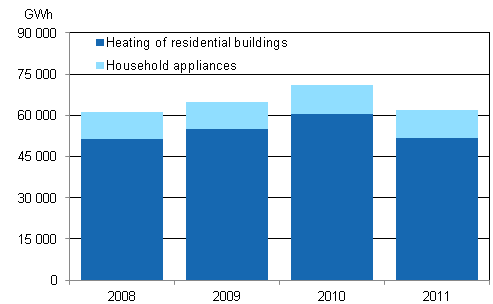Published: 16 November 2012
Over 80 per cent of energy consumption in households spent on heating between 2008 and 2011
According to Statistics Finland, energy consumption in households amounted to 61,884 gigawatt hours (GWh) in 2011. Eighty-four per cent of consumption concerned heating of residential buildings and 16 per cent household appliances. The most common energy source for heating of residential buildings was district heat between 2008 and 2011. Wood and electricity were the next most consumed sources. These three energy sources accounted for over 80 per cent of the consumption of heating energy for residential buildings. A total of 17,313 gigawatt hours (GWh) of district heat was used for heating residential buildings in 2011.
Energy consumption in households 2008–2011

The amount of electricity used on housing, or on heating of residential buildings and household appliances was 21,964 gigawatt hours (GWh) in 2011. This represents 35 per cent of the energy consumption in households. District heat was used the second most, 28 per cent, followed by wood, 23 per cent.
Detached houses accounted for 56 per cent of the heating energy of residential buildings, terraced houses for ten per cent and blocks of flats for 29 per cent. The share of free-time residential buildings is estimated to be around five per cent. About 18 per cent of heating energy is estimated to have been spent on heating of domestic water and five per cent on heating of saunas. Detached houses and free-time residential buildings consumed the most wood on heating, while terraced houses and blocks of flats preferred district heat.
Outdoor temperature has an effect on annual need for heating energy. Heating degree day is used to describe changes in that. The year 2011 was warmer than 2010, which, due to the cold first and last parts of the year, was the coldest year for a long time. For this reason, the consumption of heating energy fell by around 14 per cent from 2010. Heating energy of residential buildings comprises the energy of the main heating system and those of other forms of supplementary heating.
In 2011, energy consumption of household appliances was 10,021 gigawatt hours (GWh), which is three per cent less than in 2010. Electricity is mainly used as an energy source for household appliances, and 10,011 gigawatt hours (GWh) of electricity was spent. In addition, 10 gigawatt hours (GWh) of natural gas was used for cooking. Thirty-six per cent of the energy of household appliances is estimated to have been spent on lighting and seven per cent on cooking. The share of other electrical equipment is estimated to be 57 per cent. Other electrical equipment includes refrigeration equipment, washing machines, tumble dryers, televisions and computers with their accessories, lifts and vehicle engine block and interior heating.
With respect to the consumption of heating energy in residential buildings, the statistics are based on Statistics Finland's calculation model where various data sources were utilised. The energy consumption data for household appliances are estimated on the basis of Adato Energia Oy's survey on households' electricity use in 2006.
Source: Energy consumption in households 2011, Statistics Finland
Inquiries: Jonna Hakala 09 1734 3419, energia@stat.fi
Director in charge: Leena Storgårds
Publication in pdf-format (249.4 kB)
- Tables
-
Tables in databases
Pick the data you need into tables, view the data as graphs, or download the data for your use.
Appendix tables
- Figures
Updated 16.11.2012
Official Statistics of Finland (OSF):
Energy consumption in households [e-publication].
ISSN=2323-329X. 2011. Helsinki: Statistics Finland [referred: 17.12.2025].
Access method: http://stat.fi/til/asen/2011/asen_2011_2012-11-16_tie_001_en.html

